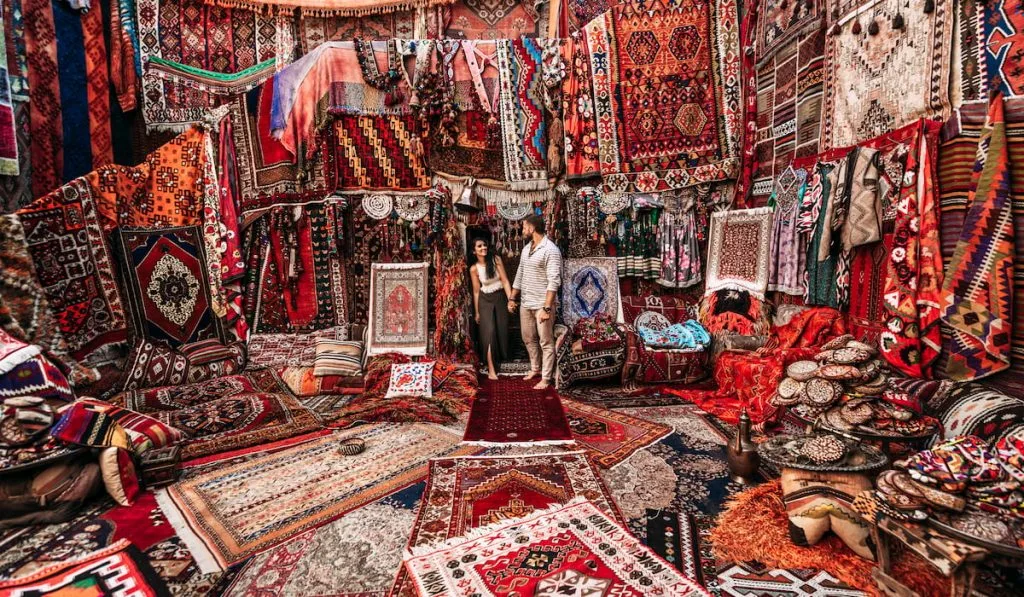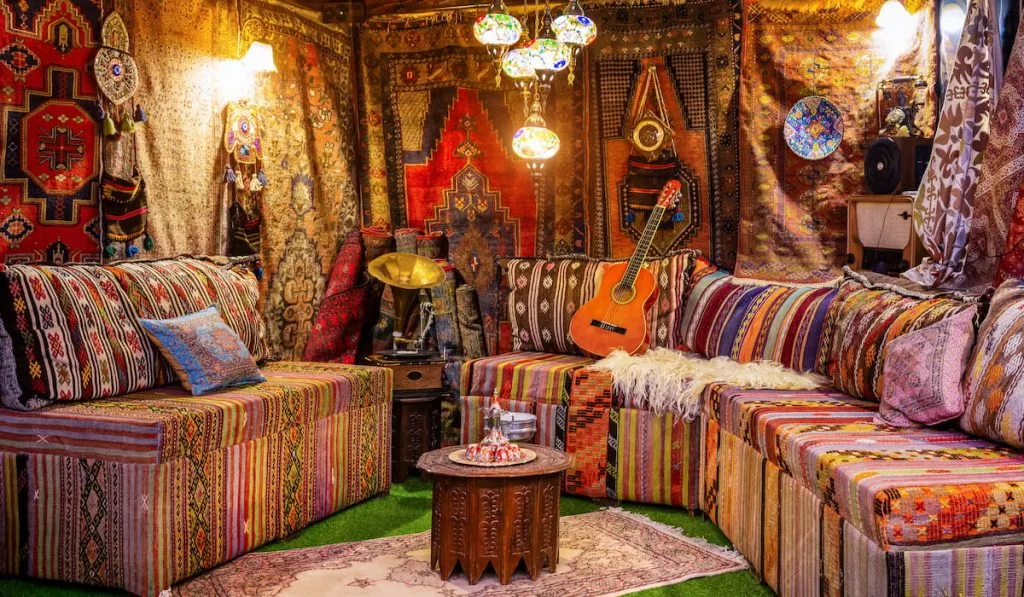If you are an interior décor enthusiast, you most likely have heard, seen, or come across oriental rugs. Because of how they look, you may wonder how they can be used in decorating a home.
Keep reading this article to learn all about oriental rugs and 9 tips on how to use them to decorate your home.
What are Oriental Rugs?
Oriental rugs are basically any kind of carpet hand-knotted in the Asian region. They are rugs made in China, Iran, Russia, Turkey, etc.
Oriental rugs are made by hand-weaving strings of yarn of different colors to create ornamental designs. With the growth of modern technology, most rugs are made with machines. However, true oriental rugs have retained their hand-weaving process.
Oriental rugs are primarily made from wool. But, other materials such as silk and bamboo have also been used for making oriental rugs.
One selling point of oriental rugs is the versatility of designs. They can be made in various designs, shapes, patterns, and colors. Most creators use multiple contrasting colors and textures to create a three-dimensional effect.
Brief History of Oriental Rugs
Oriental rugs were first documented in the Sassanid period (224-642 CE). Records show that the court of Achaemenian of Cyrus the Great was enamored with these beautiful rugs.
2500 years ago, it was said that Alexander II of Macedonia fell in love with the carpets in the tomb area of Cyrus. The popularity grew and spread across different regions in Asia to become very popular in modern times.
Oriental rugs are known to exude royalty and elegance when used. There are various methods of making oriental rugs and they are mostly handmade.

Types of Oriental Rugs
The versatility of oriental rugs is one of its most alluring attributes. There are different types of oriental rugs you can choose from to decorate your home.
- Chobi Ziegler. These types of oriental rugs are the more traditional types. Their color schemes are very subtle and soft. The knots of the Chobi zigler are usually lower than the other types of oriental rugs.
- Persian rugs. These are oriental rugs that are handmade in Iran, which was previously known as Persia. Persian rugs are the oldest and most respected rugs out there. They are made with more traditional colors like red, brown, blue, beige, blue and gold. They have patterns such as flowers, fruits, combs, etc. Persian rugs are the highest quality oriental rugs and are made with many knots.
- Tribal or Nomadic Rugs. These oriental rugs are made by people living in nomadic areas. They are small pieces of rug created for easy transport. These kinds of rugs do not use a wide variety of colors or patterns.
- Village rugs. These are rugs woven by people in rural areas. They are primarily made with wool or cotton.
- City rugs. These rugs are made in modern times in urban areas. Rugs made here are primarily made for exporting. They are usually made from cotton materials. They are versatile in colors and designs.

How to Decorate Your Space with Oriental Rugs
Decorating your home with oriental rugs can be quite tricky, especially if you are new to the world of oriental rugs. Here are 9 tips that will help you in using oriental rugs to decorate your home.
- Determine the size of the rug to buy. Oriental rugs come in all shapes and sizes. These shapes range from a small floor mat to full flooring material. Smaller rugs can be used in more places than larger rugs. If you want to use the rug to decorate only a certain area of your house, you must measure the length and width of the available space. This helps you in knowing the dimensions of the rug to purchase. Do not buy the exact dimension of your measure space. Subtract about 2 or 3 inches from the main area to be covered. This extra room brings out the beauty of the rug and prevents the decorated area from looking choked up.
- Think about your existing interior in mind. Before you purchase your oriental rug, you have to first consider the interior design of your house, that is, if your house is already decorated. If your wallpaper and upholstery are deeply patterned, you should get a plain rug to complement the existing décor. If the interior of your house has different distinct patterns, it tends to look like a scene of the nightmare of a 2-year-old. On the other hand, if your existing interior leans towards the plain and calm side, a heavily patterned rug is exactly what you need. If your house is not yet decorated, you can get an oriental rug you love and decorate the remaining part of your house around it.
- Personal taste and preference. Every individual varies in their taste and creativity. You do not want to copy a design off the internet and then dread coming home every day because you feel like a stranger in your own space. Let your taste be the priority. Choose colors that you like. Find out good color combinations and let them guide you in choosing your rugs.
- Purpose of the rug. Some people buy oriental rugs primarily to protect their original flooring in place of their decorative attributes.
- Using multiple rugs in the living. If you have a really large living room, it can be quite tempting to buy one huge Oriental rug to cover the space. However, this can leave your living room looking bland and off. Your living room will look better with multiple rugs with different yet subtle patterns. You can place oriental rugs in different locations of the room. One by every door entrance, one close to the television set. One at the center of the room, etc.
- Choosing the right material. It is imperative to consider the type and quality of the material when shopping for ornamental rugs. The quality of an item is directly related to its durability. Rugs made of natural fiber are the most resilient. Also, silk and wool rugs are known to be very durable.
- Consider the shapes of the rugs. Different shapes of ornamental rugs will work better in the specific shape of the room. For instance, long rectangular rugs will work better in the kitchen and bathroom.
- Foot traffic. Always consider the amount of foot traffic the area of your oriental rug will receive before purchasing them. Foot traffic equates to wear-and-tear, more dirt, water, etc. Areas with high traffic such as the living room should receive oriental rugs that are strong and durable.
- Use rug pads before placing your rug. it is important to cover the existing floor or carpet before placing the ornamental rug on it. It helps add an extra layer of protection and also prevents damage to your main floors.

Care and Maintenance of Oriental Rugs
After decorating your home with your rugs, you have to know how to take care of it to extend its lifespan. Here are a few ways of taking care of your rug.
- Rotate Regularly. Rotating your rugs at least every one or two months will help to protect the quality. If your rug is located in high foot traffic areas, rotating it will help in spreading the amount of foot traffic on the rug and evenly distributing the wear. This is to prevent one side of the rug from looking old and worn while the other side is looking newer.
- Do not place under direct sunlight. Direct sunlight can cause the colors in your rug to fade over time. Place your rugs strategically in areas where direct sunlight do not get to. If you cannot find such locations, regularly rotate.
- Do not place in moisture-prone areas. Do not place your rug in areas prone to water spillage. A moist rug can lead to growth and buildup of microorganisms such as mold or mildew. This can lead to health issues and challenges. Always place your rug in cool and dry areas especially if they’re very large and will not be easily cleaned.
- Vacuum. All rugs should be vacuumed regularly to remove dirt trapped between the materials of the rug, oriental rug even more so as it is easy for more dirt to be trapped between the natural fibers.
- Flip the rug. The fringes on oriental rugs require that the rugs should be flipped regularly to allow twists formed from foot traffic to loosen out. Do not try to loosen these twists with your hand as these can cause damage to the natural fiber.
- Remove stains immediately. Once you notice any stains on your rug, it is very important you clean immediately. Long-standing stains can ruin the exterior of your rug and can even become permanent.
- Professional Cleaning. Rugs are recommended by experts to be professionally cleaned every three years. This is to get rid of the build of dirt and stains.
- Airdry your rug once in a while. While there is no hard and fast rule on the frequency of airdrying your rugs, make sure to airdry your rugs as regularly as you can. If your rugs are placed in moisture-prone areas, always airdry them as much as you can.
- Utilize Padding. Before placing your rug on the floor, always pad it to prevent excessive friction which can leave to a breakdown of the materials of the rug.
Oriental rugs are intricate pieces used to decorate spaces. They come in different sizes and patterns. They can be placed in the kitchen, living room, bedroom, etc. The kind of oriental rugs you should use to decorate your home should be largely dependent on your tastes and preferences as an individual.
Resources
- https://www.carpet-wiki.com/identify-handmade-rugs
- https://nazmiyalantiquerugs.com/blog/home-interior-decorating-with-antique-rugs-persian-oriental-carpets/
- https://www.catalinarug.com/blog/4-tips-for-decorating-with-oriental-rugs/
- https://mansour.com/blog/how-to-guide-decorating-your-home-with-oriental-rugs-by-mansour
- https://www.paradiseorientalrugs.com/decorating-with-oriental-rugs
- https://www.sheffieldfurniture.com/otherpages/rughistory.html
- https://abchomecare.com/blog/2018/04/12/nine-tips-for-maintaining-your-area-and-oriental-rugs/
- https://www.abc-oriental-rug.com/Oriental-Rugs-types-and-formats.html
